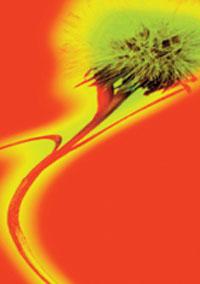Color of alien plants

On earth, yes, most of the plants are green. And out of the Earth, or rather, out of the solar system? If there were vegetation on another planet, should it be necessarily green? In an investigation carried out at NASA it is stated that no, that the properties of the Earth make the plants have a green color and that in other conditions can grow plants of another color.
Chlorophyll gives the green color to terrestrial plants, a molecule essential to realize photosynthesis. Chlorophyll is a pigment, that is, a molecule that reflects the light of a certain color (green). It gives color to plants because it reflects light, but also absorbs light. Thanks to this absorbing light, the plants obtain the energy necessary to produce organic matter from water and carbon dioxide.
Why chlorophyll?

Terrestrial plants are adapted to the conditions of the environment. The Sun emits rays of certain colors and characteristics, some more than others. Before reaching the ground, the rays cross the atmosphere and the gases of the atmosphere absorb part of the light. As a result, in the light that reaches the Earth, the red and blue rays are the most abundant. The use of this light by the plants is as satisfactory as possible, it is precisely this color that most uses chlorophyll.
However, the light does not come equally to all places on Earth. In water, for example, the properties of light change. On the one hand, when the water falls, part of the light is reflected without entering the water. On the other hand, particles dissolved in water and in suspension absorb light. The more turbulent the water is, the less light reaches aquatic photosynthesizing organisms. Organisms that live in turbulent waters have adapted to these conditions. For example, a type of bacteria that inhabit this medium uses infrared light for photosynthesis, since it is the most abundant it has around it.
In view of this diversity on Earth itself, on planets outside the solar system it is very likely that physical conditions are different, that is, that the light emitted by each star has other properties, that the planets that can have life have a different atmosphere... Therefore, on those other planets photosynthesis does not have to be as on Earth, nor plants, of course. The color of the plants can be yellow, red, blue or any other planet.
Looking for the footprint of the plants

NASA researchers want to know if there are plants that perform photosynthesis on some planet outside the solar system. Various research has detected signs of yes: they have discovered that on some planet there are the necessary conditions for organisms to perform photosynthesis and photosynthesis to occur.
From there, NASA wants to go further. They want to know what kind of light would reflect if there were plants on a planet and how it would look from space. Once this is known, they believe that plants can know which pigments make photosynthesis and under what conditions. For this purpose, the light absorbed and reflected by the living photosynthesizers of the Earth has been analyzed in the first place. They have already taken the first step, but they have a long way ahead.
Published in 7K.
Buletina
Bidali zure helbide elektronikoa eta jaso asteroko buletina zure sarrera-ontzian











